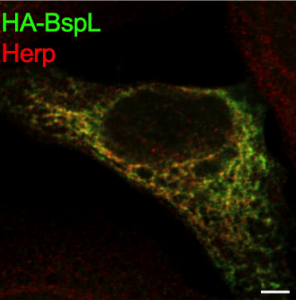Brucella effector hijacks endoplasmic reticulum quality control machinery to prevent premature egress
Preprint posted on 11 July 2019 https://www.biorxiv.org/content/10.1101/699330v1.full
Brucella 1: 0 host cell, Brucella gains upperhand against its host by employing its T4SS effector to take control of the ER quality control machinery.
Selected by Vikash SinghCategories: microbiology, pathology
Background:
Most intracellular pathogens have devised mechanisms to establish a replicative niche within their host cells. These intracellular pathogens employ their secretion system to inject a cohort of effector proteins directly into their host cell, thus subverting key host defense mechanisms. Furthermore, they have developed diverse strategies to avoid or survive the hostile environment of the macrophage phagosome: they can prevent phagocytosis (Yersinia species), alter phagocytosis to target the bacterium to a novel phagosome (Salmonella species), escape from the phagosome into the cytosol by lysing the vacuolar membrane (Listeria and Shigella species), block the fusion of phagosomes with lysosomes (Legionella species), block or attenuate acidification of phagolysosomes (Mycobacterium tuberculosis), or adapt to resist the antimicrobial activity of the fused phagolysosome (Salmonella species)1
Brucella spp., a facultative intracellular pathogen uses its Type 4 secretion system (T4SS) to secrete virulence proteins that allow it to infect and survive both in phagocytes and non-phagocytic cells and thus cause brucellosis. Upon infection, Brucella resides within a phagosome-like compartment called the Brucella containing vacuole (BCV). However, only a few effectors have been characterized for which we have a full grasp of how they contribute to pathogenesis.
Key findings:
In the study the authors identify and characterize a new T4SS Brucella effector, BspL, that is responsible for hijacking and circumventing the ER homeostasis machinery. The authors further describe that this previously unknown effector, BspL, directly interacts and targets Herp, a key component of the ER quality control system. This tight regulation of the ER quality control system allows the pathogen to effectively control the dynamics of the formation of Brucella containing vacuoles. As a result, BspL delays formation of a BCVs and subsequent release of bacteria from the cell.

In summary, the authors demonstrate that ER quality control system modulation by BspL enables Brucella to temporarily delay the formation of BCVs and avoid premature egress from infected cells, highlighting a new mechanism for fine-tuning bacterial pathogen intracellular trafficking.
Importance:
The article further demonstrates the diversity of mechanisms that numerous intracellular pathogens employ to perturb intracellular trafficking to their own benefit in establishing and sustaining infection. This clearly opens up avenues where such pathogens could be targeted with precision, instead of using antibiotics.
Future work and key questions:
It still remains to be seen what are the precise mechanisms by which BspL regulates the ER quality control system. Does BspL prevent the degradation of Herp? Does the binding of the effector to Herp add to the stability of the complex? Under such ER stress, what is the status of the other autophagy machinery systems? Does BspL act in concert with another effector (yet to be identified) that influences Herp stability?
Recently, ER has been shown to form associations with mitochondria and lysosomes and play an important role in local protein synthesis. Is it early to predict from these data that the association of BspL with ER can also be playing a role in such a specialized local system?
References:
- Pizzaro-CerdaJ, MorenoE, DesjardinsM, GorvelJP. When intracellular pathogens invade the frontiers of cell biology and immunology, Histol Histopathol , 1997, vol. 12(pg. 1027-38).
Posted on: 26 July 2019 , updated on: 8 August 2019
doi: https://doi.org/10.1242/prelights.12498
Read preprintSign up to customise the site to your preferences and to receive alerts
Register hereAlso in the microbiology category:
RIPK3 coordinates RHIM domain-dependent inflammatory transcription in neurons
Digital Microbe: A Genome-Informed Data Integration Framework for Collaborative Research on Emerging Model Organisms
Mixed Alkyl/Aryl Phosphonates Identify Metabolic Serine Hydrolases as Antimalarial Targets
Also in the pathology category:
Hypoxia blunts angiogenic signaling and upregulates the antioxidant system in elephant seal endothelial cells
H2O2 sulfenylates CHE linking local infection to establishment of systemic acquired resistance
Bacterial filamentation is an in vivo mechanism for cell-to-cell spreading
preLists in the microbiology category:
BioMalPar XVI: Biology and Pathology of the Malaria Parasite
[under construction] Preprints presented at the (fully virtual) EMBL BioMalPar XVI, 17-18 May 2020 #emblmalaria
| List by | Dey Lab, Samantha Seah |
1
ECFG15 – Fungal biology
Preprints presented at 15th European Conference on Fungal Genetics 17-20 February 2020 Rome
| List by | Hiral Shah |
EMBL Seeing is Believing – Imaging the Molecular Processes of Life
Preprints discussed at the 2019 edition of Seeing is Believing, at EMBL Heidelberg from the 9th-12th October 2019
| List by | Dey Lab |
Antimicrobials: Discovery, clinical use, and development of resistance
Preprints that describe the discovery of new antimicrobials and any improvements made regarding their clinical use. Includes preprints that detail the factors affecting antimicrobial selection and the development of antimicrobial resistance.
| List by | Zhang-He Goh |
Also in the pathology category:
Fibroblasts
The advances in fibroblast biology preList explores the recent discoveries and preprints of the fibroblast world. Get ready to immerse yourself with this list created for fibroblasts aficionados and lovers, and beyond. Here, my goal is to include preprints of fibroblast biology, heterogeneity, fate, extracellular matrix, behavior, topography, single-cell atlases, spatial transcriptomics, and their matrix!
| List by | Osvaldo Contreras |
ECFG15 – Fungal biology
Preprints presented at 15th European Conference on Fungal Genetics 17-20 February 2020 Rome
| List by | Hiral Shah |
COVID-19 / SARS-CoV-2 preprints
List of important preprints dealing with the ongoing coronavirus outbreak. See http://covidpreprints.com for additional resources and timeline, and https://connect.biorxiv.org/relate/content/181 for full list of bioRxiv and medRxiv preprints on this topic
| List by | Dey Lab, Zhang-He Goh |
1
Cellular metabolism
A curated list of preprints related to cellular metabolism at Biorxiv by Pablo Ranea Robles from the Prelights community. Special interest on lipid metabolism, peroxisomes and mitochondria.
| List by | Pablo Ranea Robles |











 (1 votes)
(1 votes)